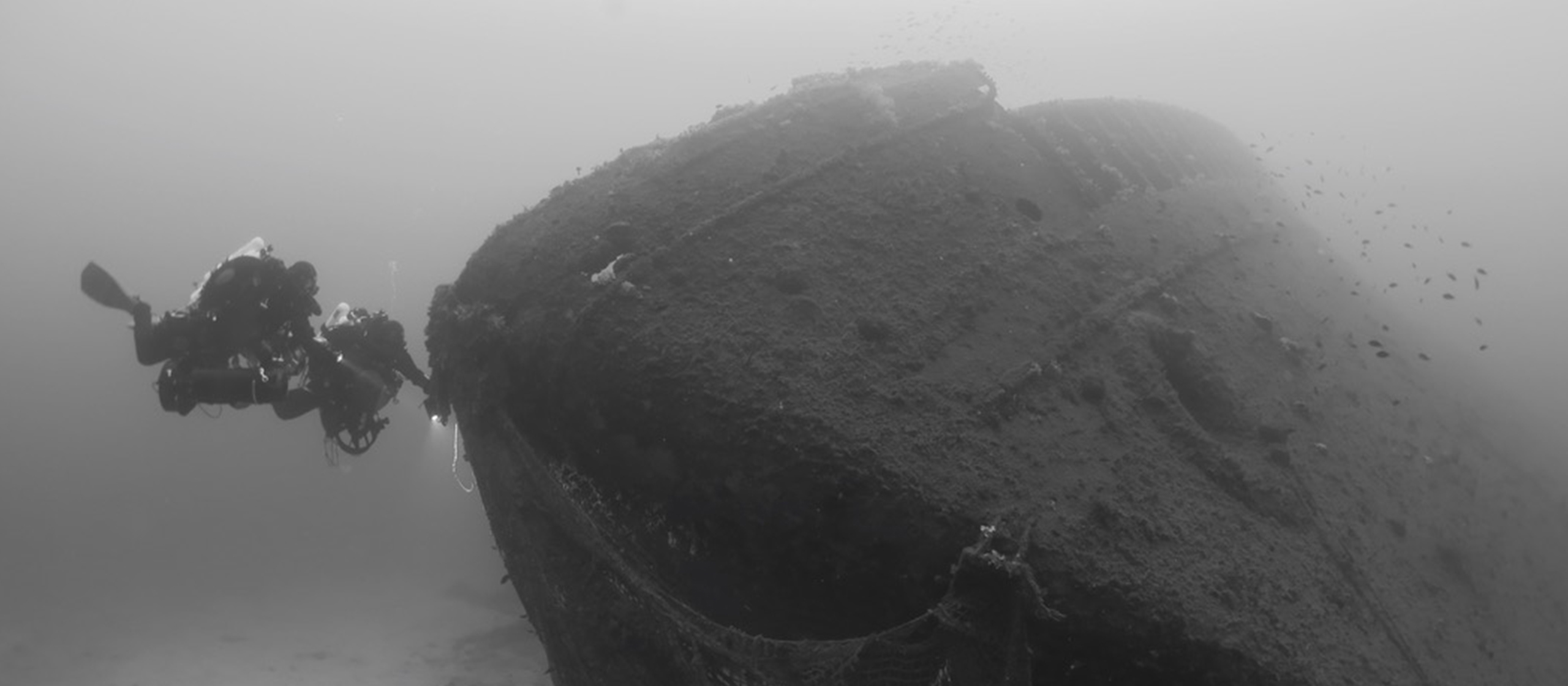Dive stories
A Dive Into History: The Battle of the Convoys
Are you a wreck lover?
I knew it. I think you will enjoy this story. It harkens back to the years 1941-1943, during World War II when the central Mediterranean was the theatre of a dramatic fight between the air and naval forces of the Italo-German axis and the British Commonwealth. The fight, known as "The Battle of the Convoys," was a critical part of the "Battle of the Mediterranean," that raged during the war. It was a long and painful struggle for the control and protection of communication and supply lines. The Italian Regia Marina had to protect the convoy routes from the mainland to the Libyan ports, especially Tripoli and Benghazi, while the Royal Navy had to ensure the protection and the safe delivery of supplies to its strategic base in Malta.
The copious number of ships that were sunk during the battle now lay on the seabed between Italy, Tunisia and Libya. Many have yet to be discovered and documented. But some have been located and ready to tell their incredible story to the lucky divers who have the opportunity to visit them.

Photo: Piero Labò
Finding and documenting these wrecks is the main focus of the Battle of the Convoys Project, which started in 2003 by Global Underwater Explorers (GUE), in collaboration with Soprintendenza del Mare (the Italian authority for marine archeology) and Regione Sicilia (Sicily Regional Authorities). Underwater explorer Mario Arena, who is a member of the GUE board of directors and longtime DAN Member, has led and coordinated the project since its inception. He explained that its purpose is to identify and document the wrecks using various means and technologies. This includes archival research, wreck status reports, video and photographic reports, 3D photogrammetry, 360° video and sonar images.
"Our main goal is to publish the results of our study and to collect enough material to support an exhibition dedicated to the Battle of the Convoys. Many of the wrecks are quite spectacular, and still filled with their cargo consisting of battle supplies and military vehicles. We want to make use of their charm to tell the incredible story of this battle to the general public," Arena said.
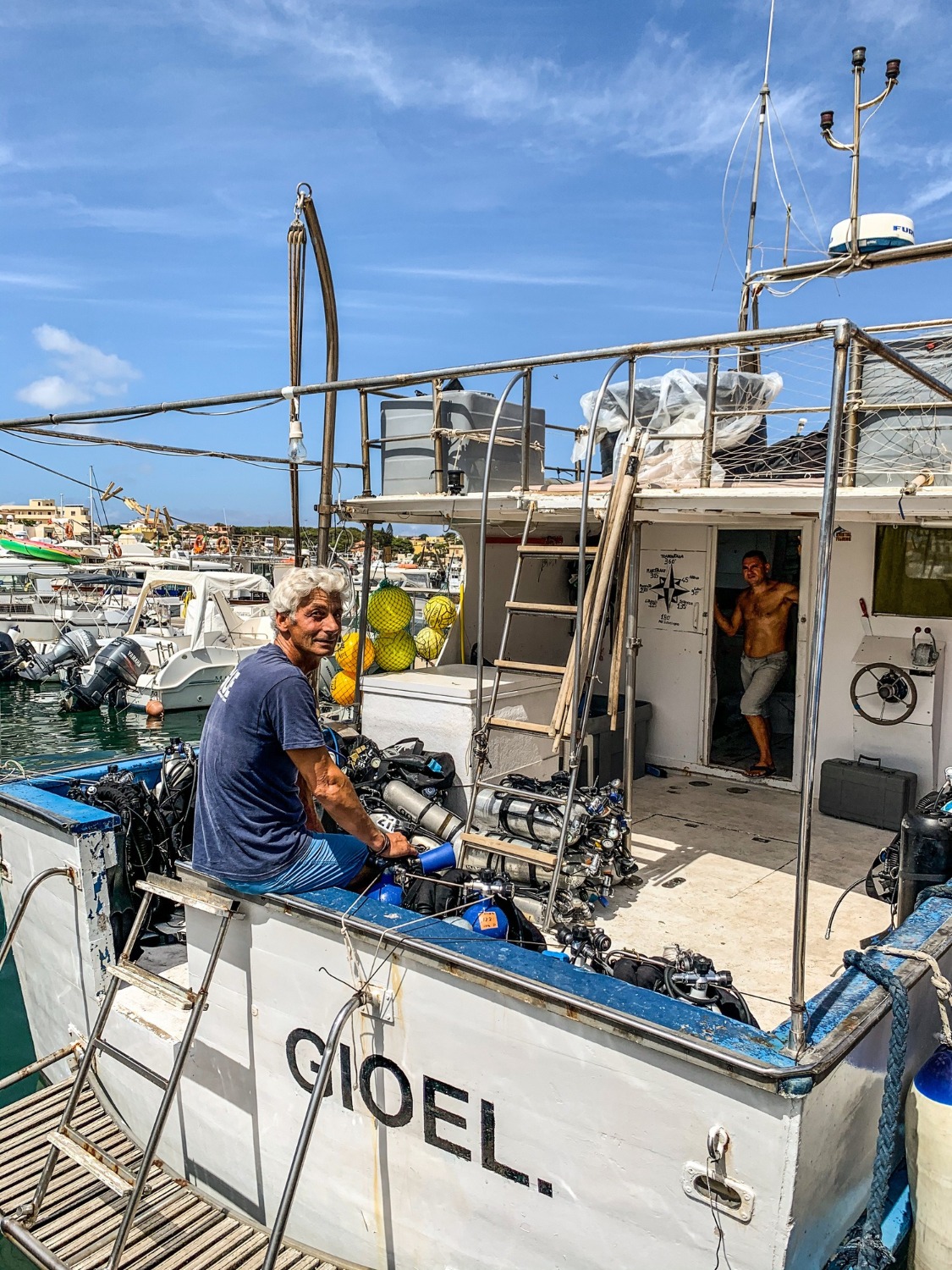
Volunteering for the 2020 Expedition
The project's 2020 expedition took place in the first ten days of September. Our base camp was in Lampedusa, Italy's southernmost island. We relied on a local fishing vessel to reach the wrecks. I was one of six volunteer divers who joined the project. Project co-organizer Francesco Spaggiari was responsible for logistical support and the safety of surface operations.
Before describing our amazing dives, there is an important aspect I need to mention: the wrecks we explored are more than 50 miles off the Lampedusa Island, in the open sea. As a result, weather can be a real obstacle for a mission of this sort. This year the wind was not very kind and we only had four good days of exploration out of the ten that we had planned. We journeyed out to the wrecks in our tiny fishing boat twice, returning to land between missions.
Of course, the boat was not originally designed to accommodate divers, even though the local fishermen were extremely helpful in finding the best way to store all our gear. In Lampedusa it’s not easy to find bigger, suitably-equipped boats. This made everything more challenging and exciting like a shipwreck expedition should be, and required a healthy dose of both flexibility and adaptability!
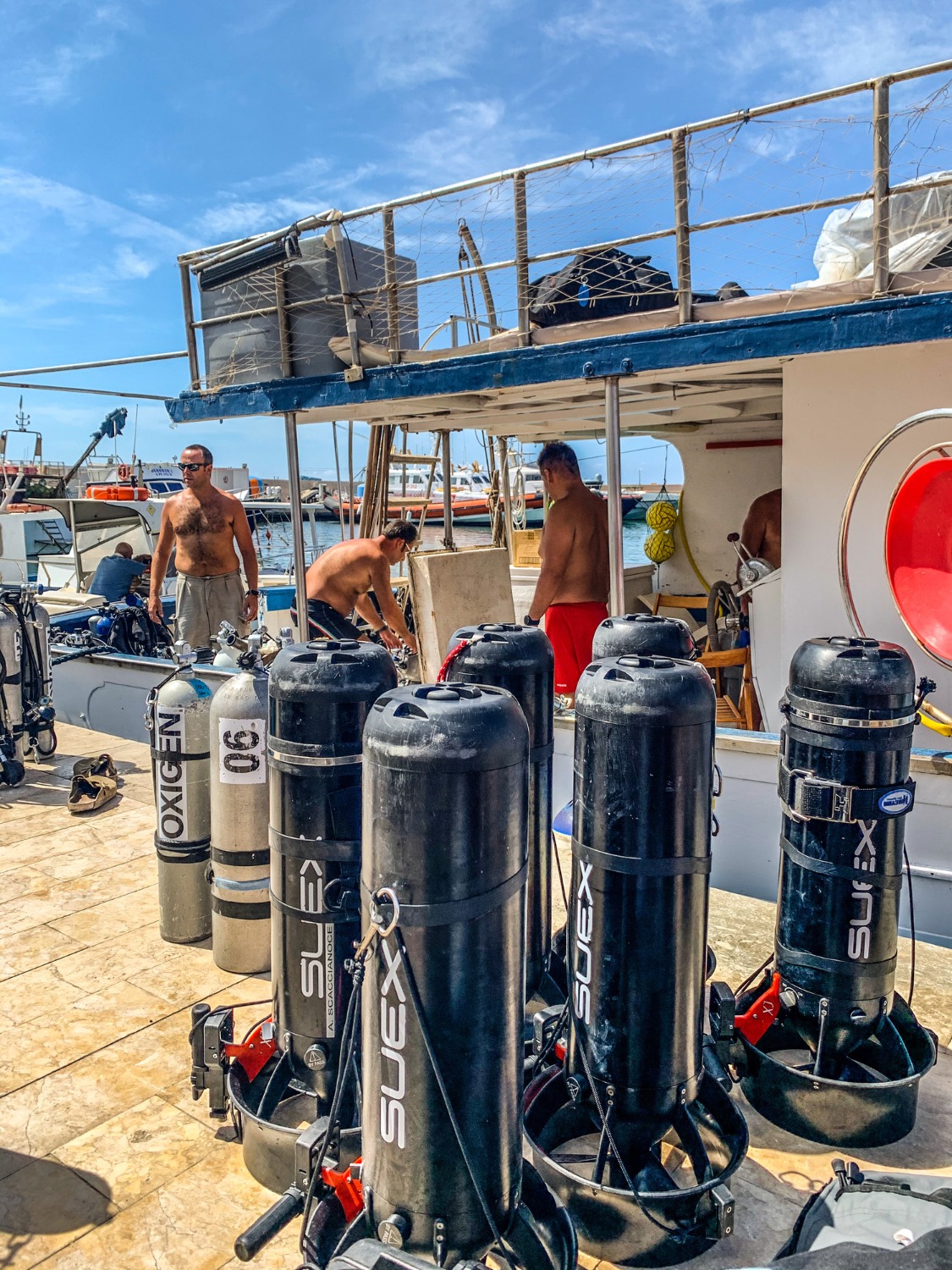

On to the wrecks
The mission for our first round of dives was to document two known wrecks, the SS Reichenfels and the submarine Le Narval, and to explore a new wreck. The SS Reichenfels is located approximately 60 miles offshore from Lampedusa, at a depth of 34 meters. It was a large cargo ship, built in 1936 in Bremen, Germany. On 22 June 1942, while in convoy from Naples to Tripoli, the ship was hit on the bow by a torpedo of a Bristol Beaufort of the 217th Squadron, based in Malta. It sunk in 15 minutes without human losses.
Laying on its right side, the wreck is full of motor vehicles of all sizes, trailers, artillery, ammunitions, aircraft bombs and other material. One of the most interesting remains is a large cannon mounted on a Lancia truck, that lies on the bottom to the side of the ship, in perfect conditions. Visibility was perfect and the wreck was surrounded by an incredible amount of fish, including huge snappers and groupers, making this dive even more special. Here we also collected two water samples, and a fish, for the Institute of Toxicology of the University of Kiel, that is studying the environmental impact of explosives leaking from containers in wrecks and ammunition dump sites.

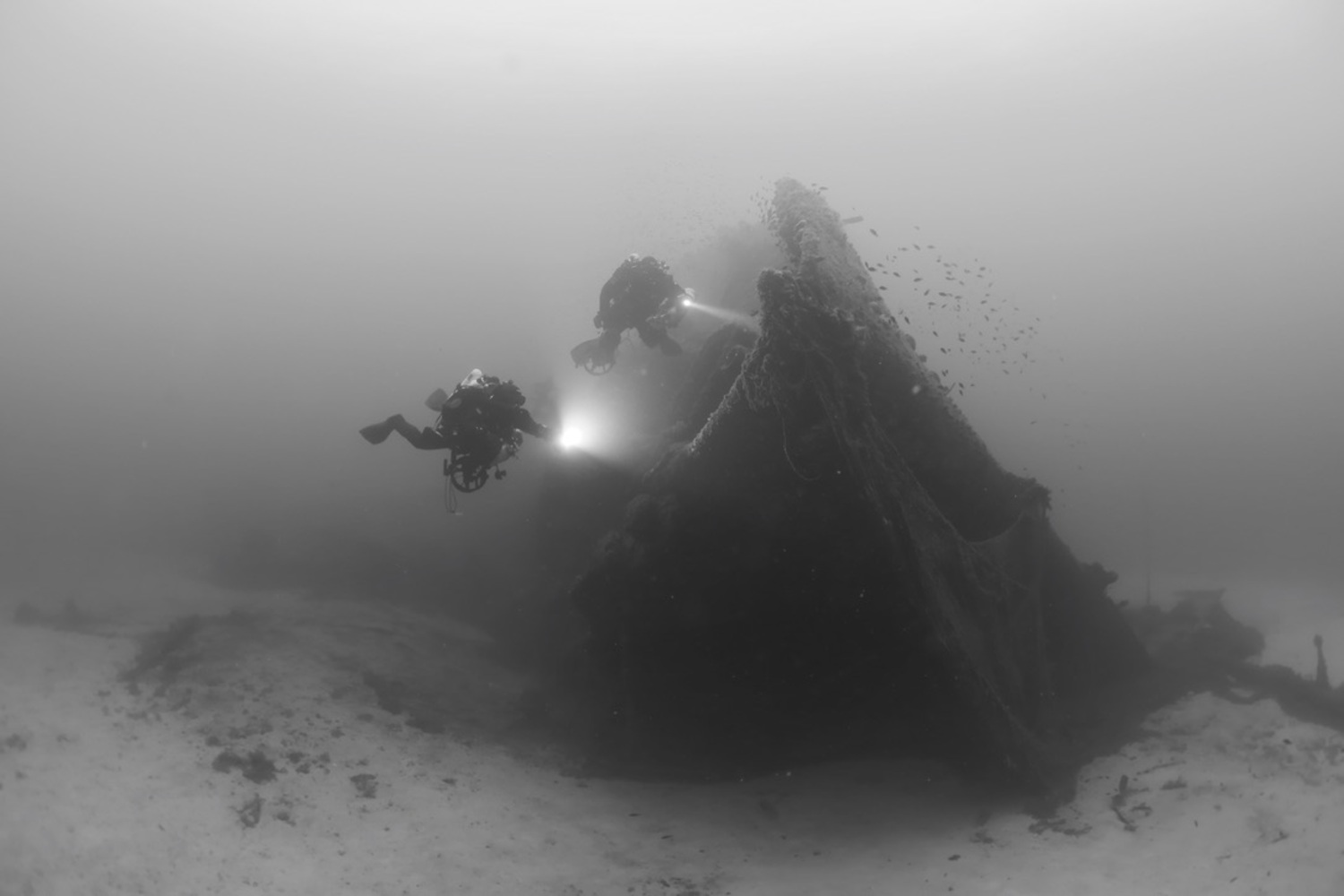
Photos: Piero Labò
Counting on surprises and fisherman
During this trip I learned two important things about the life of a wreck explorer. First, it is full of surprises. Sometimes you get phenomenally lucky. Sometimes not. But in either case, you must give it your best effort, and never miss the opportunity to explore, even when what you find is not what you expected. Second, but no less important, you need the help of a wise fisherman if you want to validate your research and find the wreck you are searching for. They not only know the seabed inside out, but since some of the best fishing occurs on and near shipwrecks, they know the nautical positions of the wrecks in their area. If you're lucky a fisherman will share their knowledge with you.
After visiting the Reichenfels, we moved 20 miles north to a place no one had ever dived before. According to Arena, fisherman had discovered a small structure lying on the bottom and retrieved pieces of wood stuck with big bronze nails. This of course aroused our interest so we decided to check it out. Excited by the prospects of discovering something new, we were able to make a single dive on the wreck. "It was a small wooden ship, likely a military vessel from World War I or maybe even earlier," Arena surmised. "The wreck is broken in two parts, and it's covered with nets. It will require a focused effort to identify it. We will likely have to first cut away the entangled fishing nets to properly identify her when we return next year," he said.
After exploring the wooden military vessel, we went on to dive the submarine Le Narval. Like the Reichenfels, it is also located about 60 miles from Lampedusa at a depth of 40 meters. She was a French Requin-class submarine built in 1925 at Cherbourg. At the time of France's surrender, the sub was supposed to join the Free French Naval Forces in Malta, but on the way it hit a mine north-east of Sfax, Tunisia, and sunk, reportedly on 15 December 1940. All 54 crew members lost their lives; the wreck is a French war grave. The Narval now lays on the sand, surrounded by lots of groupers and big triggerfishes. The bow was severely damaged by the explosion, but the sub is still completely sealed and there are no ways to enter it. We finished the dive and headed back to port in Lampedusa.
Rinse and repeat: on to the Piroscafo Egadi
Following our first trip, the weather got worse and the wind made it almost impossible to leave port for a second round of dives. We had to wait a few days on the island before we could resume diving operations. Our mission for this second trip was to document the wreck of the Piroscafo Egadi and to explore two new wrecks that had been found. This time we ventured even further away from the island towards Tunisia and Libya.
Built in 1929, the Piroscafo Egadi was a small passenger steamship used by the postal service to ferry mail between several large Sicilian cities like Trapani, Marsala and Mazzara, and the nearby Pelagie Islands, Aegadian Islands, and Pantelleria. It was torpedoed and sunk on August 30 1941. This exceptionally beautiful wreck lays on its keel at a depth of 78 meters, in excellent visibility. We shot some good footage and found an impressive intact and complete compass binnacle intact that was hidden beneath a net.

Photo: Piero Labò
Journey into the unknown
For our next dives we moved to two new locations that had never been explored before. “Several elements made me hope that we had located the wrecks of two ships that I have been searching for many years: the bow section of a Navigatori-class destroyer, and either its stern, or the ship that it was escorting when both were torpedoed and sunk," Arena explained. "I was quite optimistic about it, actually too much." At the first location, we found the wreck of a big offshore tugboat, lying straight on its keel at a depth of 80 meters, that was very well preserved with a tall tower and several water cannons. The wreck was beautiful to see, but definitely not what the project was after, so we cut our visit short and motored to the second location in the hopes of making the dive.
That's when things got interesting. As we descended, the wreck below looked like a submarine. As we got nearer though, it appeared to be the keel of a gunboat, or a similar vessel, laying on its left side. We started exploring along the deck and when we reached the bow, a diver from the other team, who was obviously excited, approached us flashing his light and signaling for us to follow. The team had found another larger gunboat near by, which was also lying on its keel. "It was pretty intriguing," Arena recounted. "We need to analyse the videos and seek out an expert for help in order to solve the mystery and identify this wreck." We surfaced from this last dive with big grins on our faces, but had to rush back to Lampedusa, before the weather hit us hard!
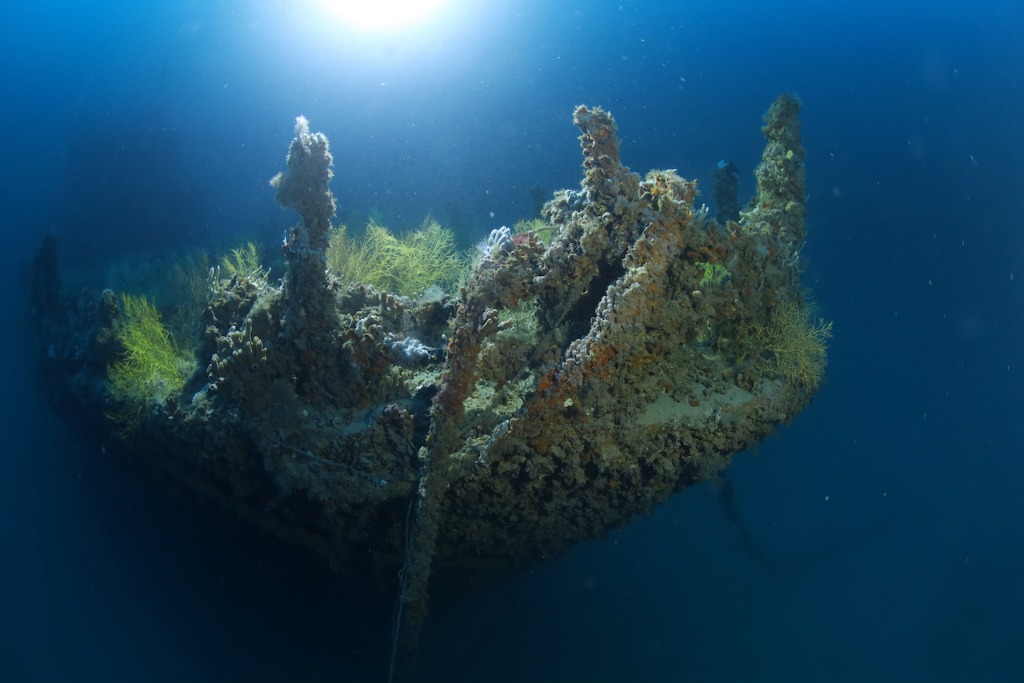
Photo: Piero Labò
So many wrecks, so little time
The Battle of the Convoys Project will continue in 2021. The research area is vast and keeps unveiling majestic treasures. If they are not already, I think everybody should be aware of the important role that the Mediterranean Sea played during the greatest conflict of modern times. The huge battles, bombings and shooting that occurred in these waters, helped save many innocent lives on land. Documenting and reconstructing these important events and their aftermath is one way to express our thanks for the sea, and all the brave souls who lost their lives during the conflict.
About the author:
Laura Marroni (BBA, MBA) is the Executive Vice President of DAN Europe. She's a diving instructor and a passionate tech and cave diver and traveller.


